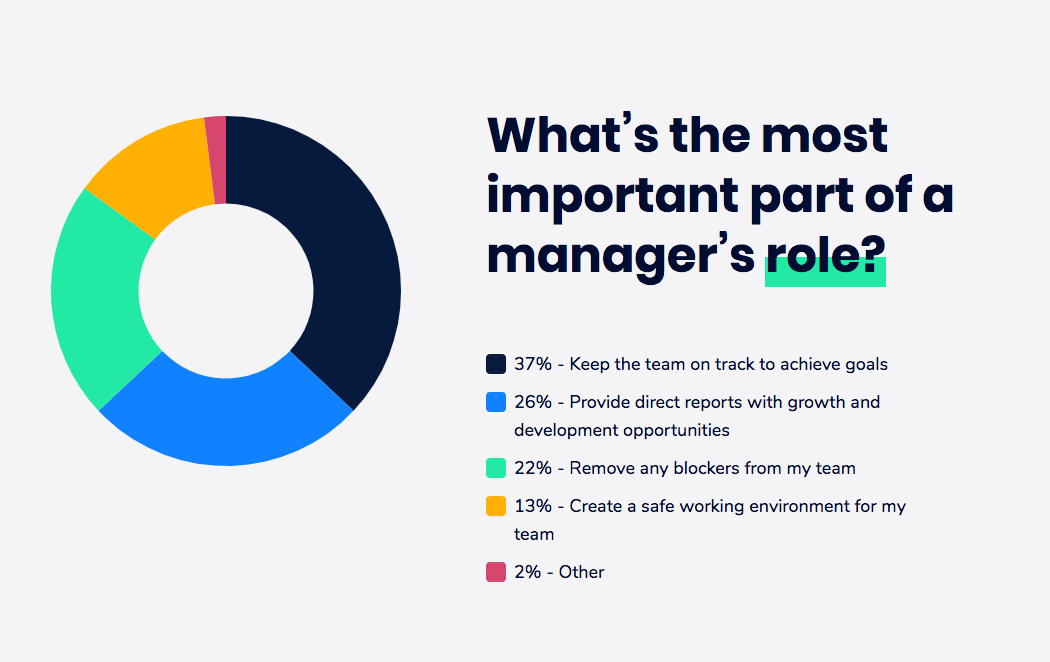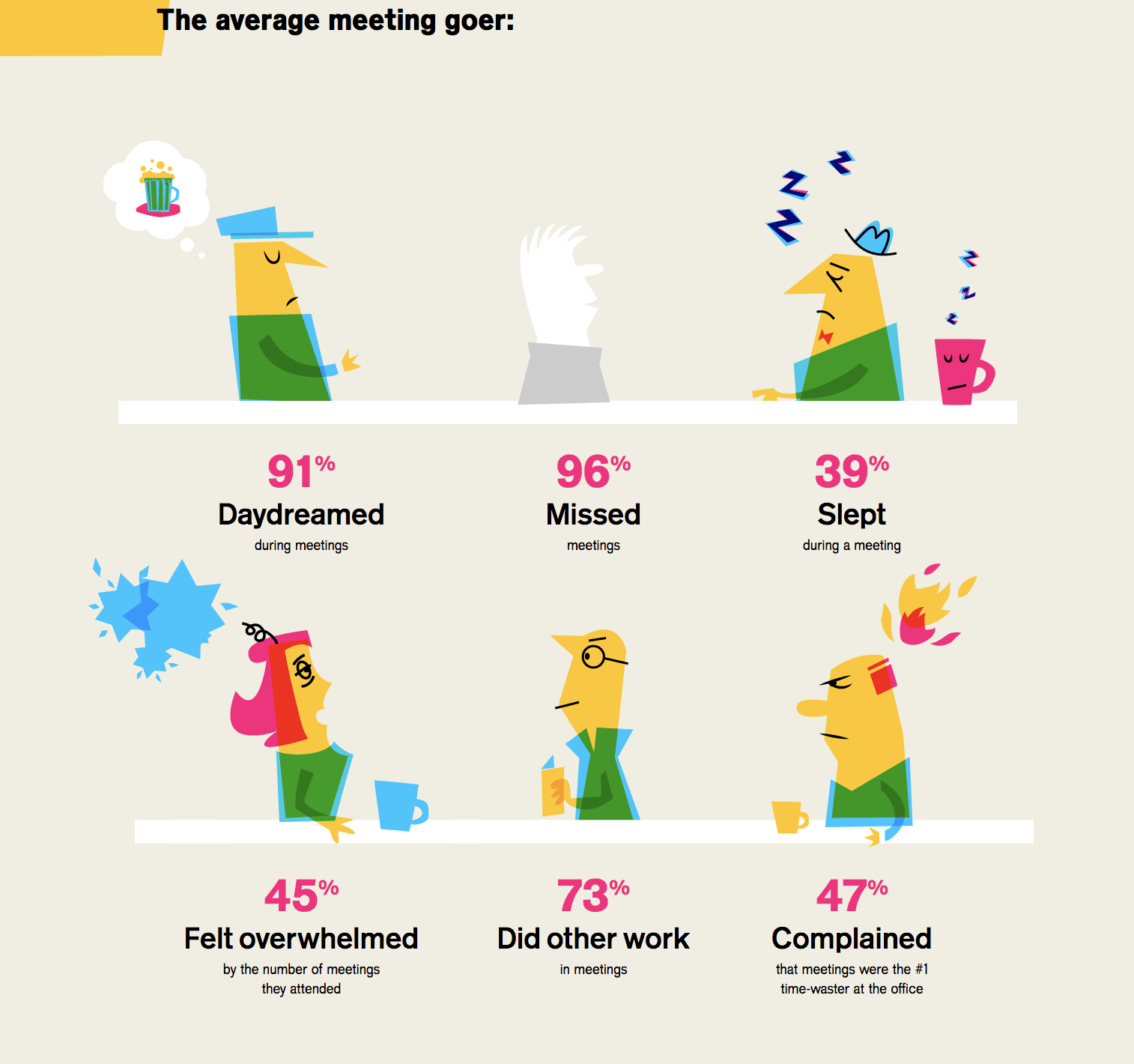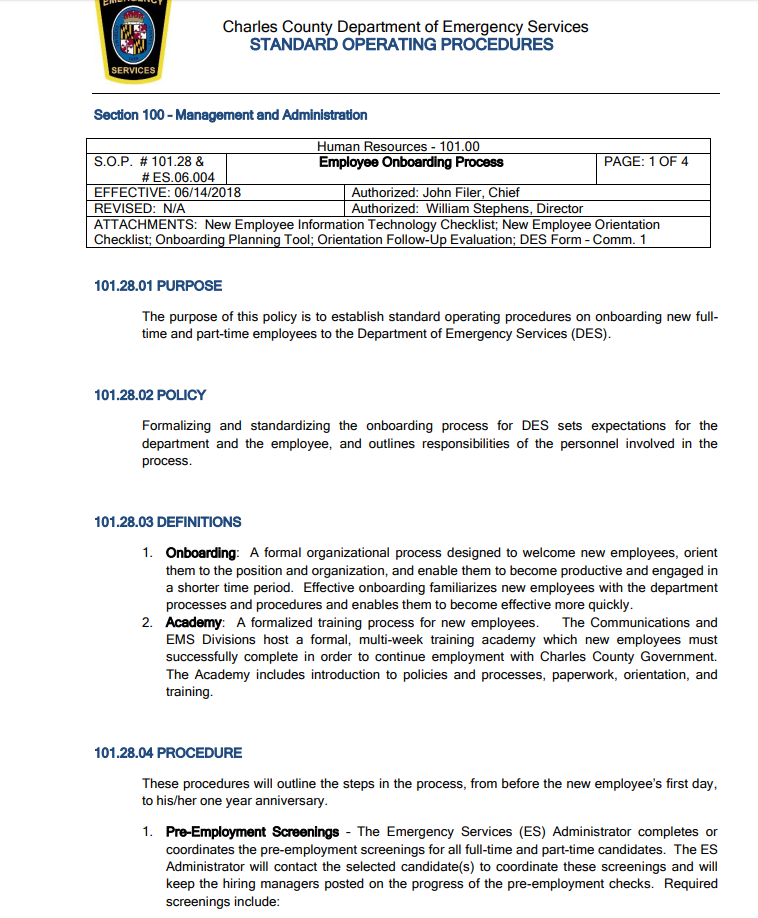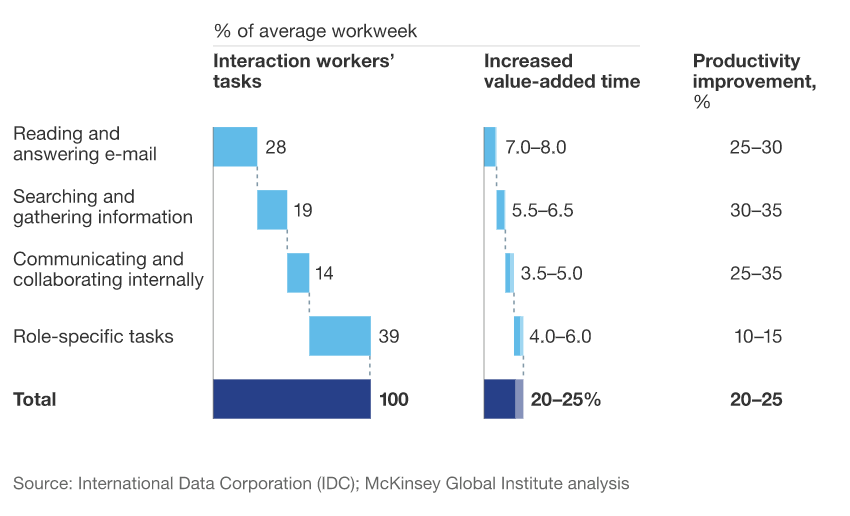
Picture this scenario:
It's Monday morning, and the team gathers around a conference table, eagerly waiting for the week’s briefing. Sarah, the team lead, looks around the room and is met with a mix of expectant and anxious faces. She knows that if the week starts without a clear direction, by Friday, the team will have spent hours on tasks that don’t align with their goals or, worse, achieve nothing substantial at all.
She also knows the power of effective team management. She remembers a time when her team would frequently lose track of their goals and spend more time putting out fires than making forward progress. That was until she stumbled upon a report from Hypercontext. A staggering 37% of managers surveyed felt that their most critical role was not just assigning tasks or holding meetings, but ensuring their team remained laser-focused on their goals.

Teams are like the gears in a machine. When each gear aligns perfectly, the machine operates smoothly. But when even one is misaligned, it can throw off the entire system. The power of alignment, setting clear goals, and seamless communication can't be underestimated.
In this article, we'll unveil the blueprint to transform your team into a well-oiled machine, focusing on eight pivotal team management strategies. Whether you're steering your team away from chaotic work patterns or refining an already effective process, the following team management strategies will serve as your compass.
- Set team goals
- Run effective meetings
- Have standard operating procedures (SOP) in place
- Make document management easy and seamless
- Have the right tech in place: team management software
- Encourage continuous employee development and learning
- Foster a positive team culture
- Embrace flexibility in work
Ready to make every week a winning one for your team? Let’s dive in!
Unraveling the Art of Team Management
In the vast arena of management and leadership, team management emerges as a refined art. It's a dance of balance, requiring the choreography of a multitude of skills, behaviors, and understandings. Let's journey through the intricacies of what this entails and the indispensable role of an adept team manager.
What is Team Management Really About?
At its core, team management transcends the straightforward notion of coordinating a group of people. It's about harmonizing diverse personalities, each with its own cadence, into a symphony that achieves shared goals. It's not just about meeting objectives, but ensuring the orchestra plays in tune, with each instrument complementing the other.
Yes, the immediate responsibility of a team manager involves orchestrating tasks. However, a forward-thinking manager delves deeper, aligning teams with broader organizational objectives. They understand that the intricacies of modern-day operations demand meticulous team structures, and they step in as the catalysts ensuring the machinery runs seamlessly.
Beyond task allocation and workflow monitoring, there's a human dimension to team management. It fosters healthy relationships, ensuring each member not only respects their colleagues but genuinely collaborates with them.
The Essence of an Outstanding Team Manager
An exceptional manager isn’t gauged solely by their team's output but by the environment they foster. Every team member should have crystal clarity on their role, a burning drive to contribute to the larger mission, and an assurance that their voice resonates within the team's narrative.
Here's where the power of listening comes into play. A standout manager actively listens, engages, and acts on feedback. They lead from the front, exemplifying dedication, transparency, and resilience, ensuring challenges are met head-on, with solutions being charted proactively.
The Quintessential Toolkit: Skills of an Effective Team Manager
Steering a team towards success is much like artistry; it requires a diverse palette of skills. An effective team manager doesn't just wield one or two but has an array of competencies, both seen and unseen, that when combined, create a masterpiece of teamwork and productivity
- Active communication: True communication transcends the spoken word. It's about ensuring that messages not only reach team members but resonate deeply with them. Through active listening, a manager fosters an environment where everyone feels heard and understood.
- Emotional intelligence: Beyond the figures and spreadsheets, a workplace is a dynamic environment filled with emotions. An effective team manager senses, understands, and navigates these emotions, ensuring that conflicts are resolved and harmony is maintained.
- Strategic hiring: A winning team starts with its members. Recognizing and recruiting talent that aligns with the team's ethos and objectives is paramount. This isn't just about skills but about the right fit for the collective.
- Goal-centric leadership: It's not enough to simply allocate tasks. A proficient manager aligns every task, big or small, with overarching objectives, ensuring that every effort propels the team closer to its goals.
- Mastery in delegation: Knowing when to take charge and when to trust team members with responsibility is a nuanced skill. Effective delegation is about recognizing the strengths within the team and allocating tasks accordingly.
- Problem-solving acumen: In the face of challenges, an effective manager doesn't falter but stands firm, guiding the team with solutions and strategies. This prowess in tackling problems head-on ensures that hurdles become stepping stones for the team's success.
In the realm of team dynamics, the role of the team manager is akin to a maestro, guiding each musician to create a harmonious masterpiece. So, if you're poised to lead, understand that it's a journey of continuous learning, adaptability, and passionate orchestration.
Effective Team Management Strategies
In today's dynamic business landscape, the ability to manage teams effectively is more than just a desirable skill—it's a necessity. A well-managed team can drive innovation, boost productivity, and achieve organizational goals with finesse. Effective team management requires a harmonious blend of various strategies, from clear communication to recognizing individual talents. As leaders navigate the complexities of team dynamics, the right strategies can turn potential challenges into unparalleled opportunities for growth. Below are some strategies that can guide leaders in nurturing high-performing teams.
1. Set Team Goals
The best thing you can do for your team is give them a direction to head towards together.
In Steven Covey’s book, 7 Habits of Highly Effective People, he writes about building the habit of beginning with the end in mind. It’s not enough to say, “Let’s have a great quarter”. You need to define what end result you’re aiming for and define the necessary goals and actions to get you and your team there.
OKR Goal Setting Framework
Depending on how your team operates, determine the goal-setting framework that works best for you. Companies like Soapbox, GitLab, Google and more operate on the OKR system.
Pioneered by the late Andy Grove, former CEO of Intel OKR stands for “objectives and key results”. OKRs tie clear objectives with ways to measure how to reach those goals.
When creating OKRs, create challenging, but not discouraging goals. The sweet spot is hitting 60-70% of your goal. If you score lower, the team isn’t achieving enough of what it could be, or the goal isn’t achievable. Scoring higher means that the goal might not have been set high enough in the first place.
Create Goals Collaboratively with the Team
When defining what you want to achieve in your given time frame (i.e. quarter, year, etc), be sure to define your goals collaboratively with the team.
By doing this, you will be able to:
- Encourage your team to participate in key decisions
- Keep your team accountable for the goals you committed to
- Get immediate feedback on what the team feels is achievable (and not)
- Include more ideas on how to best achieve your team goals
The best way to define your goals with the team?
Allocate time during your next team or quarterly planning meeting to discuss team goals. Share the goals that you have set for the team and open up the floor to everyone to share their thoughts, concerns, and ideas.
Review Your Goals on an Ongoing Basis
Once you’ve set your goals, keep it as a recurring item on your team meeting agenda. Consistently reviewing your goals and progress during this time will reinforce how everyone’s individual KPIs ladder up to what the overall team and company objectives are.
Rather than getting nitty-gritty with numbers, focus this time on:
- How you’re tracking against your goals
- What you need to do between now and the end of your timeline to achieve those goals
2. Run Effective and Productive Meetings
Considering that most managers feel that the most important part of their role is to keep the team on track, one of the best ways to do that is by running effective, productive meetings. But, for many teams, meetings tend to be a waste of everyone’s time because they’re not run effectively. In fact, an Atlassian report found that for the average meeting goer:

(Source)
Meetings are inevitable. However, not all meetings are necessary. Before you move forward with the productive meeting checklist below, you’ll need to understand why you’re meeting and what you hope to get out of it.
In Andy Grove's book, High Output Management, he breaks meetings down into two types:
1. Process-oriented meetings
These are meetings that you would have more frequently. Generally, these meetings are run with the goal of sharing knowledge amongst the team. Examples of this type of meeting could include your recurring team meetings, one-on-ones, retrospectives and more. Everyone who is a part of these meetings should know:
- How the meeting is run
- What is typically discussed
- What the goal of the meeting is
2. Mission-oriented meetings
These are more ad-hoc meetings. The purpose of this meeting is to produce a specific output, like making a decision. For these meetings to be successful:
- Someone needs to be in charge of this meeting and accountable for the outcomes of it
- There must be a clear understanding of the objectives and goals of the meeting among all attendees
In an ideal world, these meetings rarely occur because all of the things you would cover in this type of meeting would have been covered during your process-oriented meetings. According to Grove, however, you can expect that process-oriented meetings will take care of 80% of your team's issues and problems. The other 20% will be covered in these types of meetings.
Overall, when you’re able to run effective meetings, you’ll be able to better align and create a more cohesive team.
Productive Team Meeting Checklist
If you’re not sure how you can improve your meetings, here are 12 things you need to do to have productive meetings.
Pre-meeting:
- Attendance: Make sure everyone who needs to be there can be there.
- Set a meeting goal: Don’t have a meeting for the sake of meeting.
- Share the agenda in advance: Encourage everyone to contribute to your meeting agenda.
- Prepare for the meeting: Set the precedent on your team that everyone should come to these meetings prepared to discuss what’s on the agenda.
During the meeting:
- Remove any distractions. This can be as simple as putting laptops down and setting phones to silent.
- Follow your agenda: You made one for a reason… Follow it.
- Take notes: Keep a record of what was discussed, the decisions you made, and why you made those decisions.
- Encourage people to speak up: This is especially true for team meetings. The team is not made up of just one voice, but a collection of many.
Post-meeting:
- Send out meeting notes to everyone: Make it as easy as possible for everyone to access the meeting notes to avoid repetitive conversations after the meeting has ended.
- Assign meeting follow-up: Keep individuals accountable for what they agreed to during the meeting.
- Ask for meeting feedback: Do people feel better about the upcoming week? Did they feel that the meeting was a good use of their time?
- Iterate on that feedback: If your team is telling you that the meeting wasn’t a great use of their time, ask them why. Action the feedback that you receive to be more productive in your next team meeting.
3. Have Standard Operating Procedures (SOPs) in Place
A standard operating procedure is a document that provides explicit directions for completing a certain task. SOPs provide clear-cut directions into how teams and individuals should go about completing certain processes.
The Importance of SOPs
There are many benefits that come with implementing SOPs on your team, the biggest being a reduced need for managers to micromanage their teams.
According to Teresa A. Daniel, author of Stop Bullying at Work, micromanaging “squashes the spirit and motivation of even the most talented and driven employee”. Micromanaging can quickly lead to burnout, or worse, voluntary turnover.
Although there are many ways to teach a micromanager to chill, a great start is by implementing SOPs for your team. Here’s why:
Systematize processes to allow managers to take a step back
When teams are able to document and build out processes, it allows everyone to move forward in a cohesive manner. Your team will reduce the time and effort (and mistakes) that can come along with doing something for the first time. With a systemized process, managers can take a step back from being involved with every stage of the planning and execution of tasks.
Keeps everyone on the same page (and accountable)
With everything documented in one place, individuals are more accountable to adhering to best practices and internal processes.
However, when building SOPs, this should not be a top-down approach. Rather, involve all relevant stakeholders and individuals who have the knowledge needed to build out a process that’s in the best interest of the team’s productivity and the organization as a whole.
Example SOP Use Cases
There are many use cases for building out SOPs. Let’s walk through some use cases, to give you a better idea of how to implement and use one for your team.
Employee Training and Onboarding
A Harvard Business Review study found that nearly 33% of new hires look for a new job within their first 6 months; a lot of this turnover is due to a poor onboarding experience or a lack of proper employee training. SOPs allow your team to ensure that every new individual who joins your organization is set for success from day one by standardizing what steps should be taken to properly onboard and train new employees.

(Source. Example of an SOP for onboarding employees from Charles County Department of Emergency Services)
Maintaining business knowledge
Employee turnover is inevitable (and that’s okay). Whether it’s individuals quitting, getting promoted, or retiring, people will turnover at some point. That’s why you need to make it as easy and seamless as possible for the people taking over those responsibilities to have all of the necessary information required to pick up where the last person left off.
How To Write an SOP
When creating your standard operating procedures, there are a few things you should keep in mind.
Determine your goals: Why are you creating this document? What is the end-user supposed to gain from reading this document?
Involve the necessary stakeholders: Who needs to be involved in creating this document? This should be a collaborative effort. A top-down approach that excludes the very individuals who will actually be going through the motions of the defined process will not work.
Determine what information should be included (and how to present it): If the SOP is more overwhelming than helpful, it’s no longer useful. When creating your SOP, write it as if you’re sharing it with someone who is completely new to the organization.
Write it and have multiple people review it: This is when you actually put all of those discussions and planning into action. But, before you release your SOP into the wild, have different individuals read through the document and provide you with feedback.
Pro tip: When writing an SOP, try using the 10/50/99 approach to avoid having to completely restart the project because of a simple misunderstanding (i.e. misaligned goals for the document).
Continue to improve and iterate your process: Your team, organization, and industry will evolve over time. Maybe a new tool gets added to your tech stack and can automate certain processes. The point is, things will change over time and your SOP should evolve with those changes. This will ensure that your team continues to operate effectively.
When your team builds the habit of maintaining your knowledge document, it ensures that the knowledge, expertise, and learnings that they’ve experienced are still available to others within the organization.
4. Make Document Management Easy and Seamless
Nothing is more frustrating than sorting through an unorganized Google Drive, where files live anywhere and everywhere.
- 86% of employees surveyed face difficulties when locating specific office files
- 46% say locating office files is challenging and time-consuming
- 83% end up recreating an existing document because they were unable to locate the original
- 65% find it difficult to check, approve, and otherwise utilize office files and documents
Knowledge bases help to minimize these frustrations.
What is a Knowledge Base?
A knowledge base is a centralized space where information is stored, organized, and shared.
When created internally, a knowledge base is built with the purpose of making collaboration within an organization easier. It makes information within the company more accessible (and thus helps to make teams more productive).
How a Knowledge Base Can Improve Your Team’s Productivity
A Queens University of Charlotte study found that 39% of surveyed employees believe that people in their own organization don’t collaborate enough. A big cause for this is because of workplace silos. When information isn’t shared across teams (especially those who collaborate with one another), it makes it harder to get things done faster. It creates roadblocks rather than fuels productivity.

(Source)
In fact, a McKinsey report found that the average interaction worker spends nearly 20% of their time at work searching for relevant internal information or asking colleagues for answers. That means that at least one full day of every worker’s week is spent looking for information. Furthermore, McKinsey also found that a searchable record of knowledge (a knowledge base) can reduce the time employees spend searching for company-related information by up to 35%.
It turns out that, when you have a knowledge base in place, there is enough time in the week to get things done.
"Communication should travel via the shortest path necessary to get the job done, not through the 'chain of command.” - Elon Musk
Whether it’s a top-down hierarchy, or teams holding information hostage, when you make it hard for people to access information, you kill productivity. If you haven’t already, start building out your knowledge base and you’ll see your overall productivity levels rise.
5. Have the Right Tech in Place: Team Management Software
Speaking of building out your knowledge base, having the right team management apps in place can really help when it comes to:
- Breaking down silos
- Keeping the team accountable, collaborative, and productive
- Giving everyone on your team the tools they need to succeed
In fact, 49% of millennials support social tools for workplace collaboration, 40% of which would pay out-of-pocket for social tools to increase efficiency. There is clearly a need and demand for introducing such tools to your team.
Here are a few team management tools that can help boost productivity on your team.
- Helpjuice for building out a knowledge base (and breaking down those pesky silos)
- Hypercontext for making meetings more productive and building accountability on the team
- Slack for org-wide communication and keeping your inbox as clean as possible
- Trello for keeping everyone on top of and informed on how projects are coming along
-
Zoom for all or partially remote teams to have better-quality virtual meetings
6. Encourage Continuous Professional Development
When we think about the cornerstone of a thriving team, continuous professional employee development often tops the list. By helping team members nurture and grow their skills, not only does the individual benefit, but the entire organization does too. Take a leaf out of bestselling author Carol Dweck's book, "Mindset: The New Psychology of Success." She highlights the value of a growth mindset, where challenges transform into continuous learning opportunities.
- Training and Workshops: Consider the approaches of giants like IBM, Microsoft, and Deloitte. These companies funnel resources into training, seeing a clear link between skill enhancement and productivity boosts.
- Feedback: It's more than just words; it’s a foundation. Regular interactions, performance reviews, or simple one-on-ones can spotlight areas primed for growth.
7. Foster a Positive Team Culture
Every team operates within the context of its culture, which can be a make-or-break factor for many projects and objectives.
In Daniel H. Pink's book, "Drive: The Surprising Truth About What Motivates Us," he emphasizes the role of purpose, autonomy, and mastery in motivating individuals. When a team believes in the purpose of their work, feels they have the autonomy to make decisions, and has a path to mastery or personal growth, their collective morale and productivity soar.
A few things that can be done to help with team culture include:
- Organizing team-building activities, outings, or retreats can create a stronger bond between team members. This isn’t just about fun: teams that understand and trust one another can work together more effectively and navigate conflicts more smoothly.
- Recognizing and celebrating small victories can provide a steady stream of motivation for your team. It can be as simple as a shout-out in a meeting or a small team lunch. When team members feel their efforts are recognized, they are more likely to put in discretionary effort.
8. Embrace Flexibility in Work
In the era of globalization, the traditional 9-to-5 model isn’t just outdated, it's restrictive. Brands like Buffer show that remote work isn’t about being distant but being flexible. It’s recognizing that peak productivity doesn't always align with conventional hours. Equip your team with the best tools to ensure that wherever they are, efficiency follows.
Wrapping Up
There’s a lot that you can change and improve when it comes to boosting productivity on your team.
Start with determining your destination, and continue to make improvements on how your team gets there. This will make the difference between a productive team and one that’s not.
This is a guest post from Hiba Amin. Hiba Amin is the Content Marketing Manager at Hypercontext, a shared one-on-one and team meeting agenda app used by over 100,000 managers globally.


